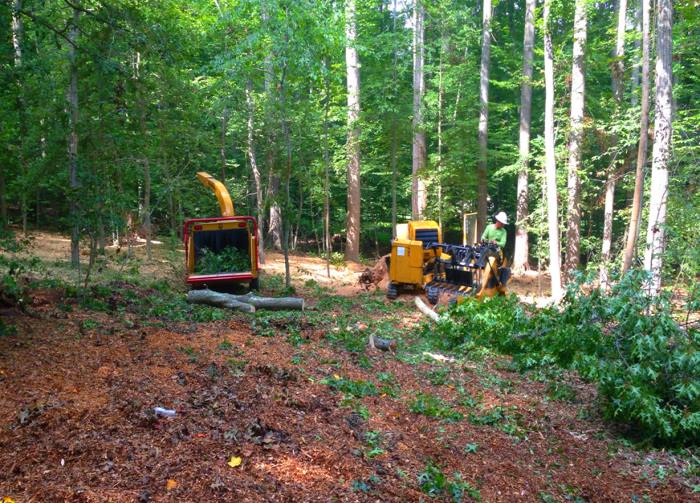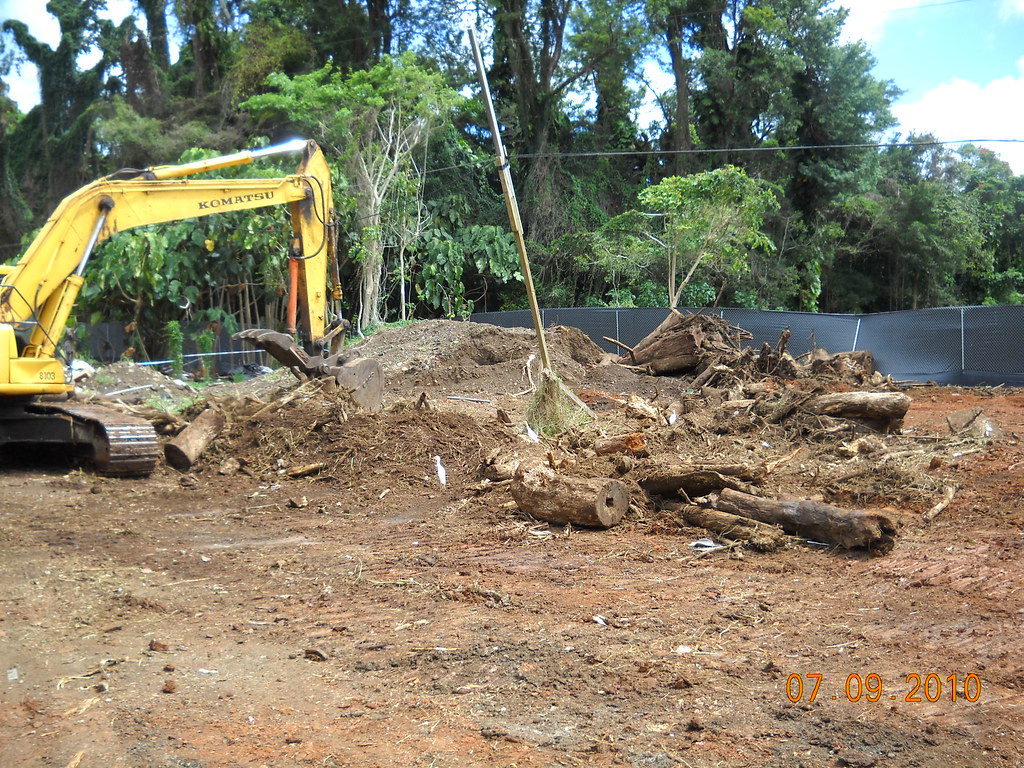Ground Clearing Servicesin Clinton Township MI
Ground Clearing Solutions for Efficient Land Preparation
We Are Locally Owned & Operated For Over 37 Years
Contact Us Today!
We Serve Businesses In And Around The Following Cities:
About Ground Clearing Services
Gaining Ground with Ground Clearing in Clinton Township
If you’ve conducted business in or around Clinton Township, you’ve likely encountered land development issues. Besides its administrative and regulatory challenges, commercial real estate development often involves a complex, labor-intensive ground clearing process. As one embarks on the journey of landscaping or construction, the utility and significance of ground clearing service providers like D&J Contracting become increasingly evident.
Ground clearing isn’t just hacking away at trees and shrubs with a machete. It’s a precise, strategic undertaking that ensures safe and effective commercial property utilization. Here we delve deeper into the process, benefits, and real-life applications of ground clearing for commercial properties in Clinton Township.
The Process of Ground Clearing
Clearing land services play a pivotal role in land development, providing a clean and workable canvas for construction. The process begins with an assessment of the terrain’s physical characteristics and the identification of potential hazards like animal habitats, unstable soil, or unexploded ordinances.
Once the land evaluation is completed, professional clearing companies gear up, employing heavy machinery like bulldozers, excavators, and grinders. Yard clearing services typically involve removing vegetation such as trees, bushes, vines, and undergrowth. In more intricate cases such as clearing trees with a skid steer, this also includes the removal of stumps and roots to ensure a level foundation. Therefore, engaging amateur services or DIY ventures might prove costly and treacherous compared to leaving the task to industry veterans like D&J Contracting.
Accelerating Development through Ground Clearing
Ground clearing offers numerous benefits, primarily speeding up land development and ensuring the land’s readiness for the construction phase. By eliminating potential delays caused by unexpected obstacles or challenges, you stay on schedule, and your cost estimates remain predictable.
However, the benefits of property clearing extend beyond the immediate development agenda. These services also improve safety by eliminating trip hazards and the threat of unkempt, overgrown areas causing fires or encouraging pests like rodents.
Furthermore, a well-cleared plot contributes positively towards environmental sustainability. Good clearing practices protect surrounding areas from potential harm caused by poor drainage, soil erosion, or landslides. Proper clearing and grading of the land also encourage efficient water runoff, reducing the potential of flooding.
Ground Clearing in Real-World Applications
Take, for instance, the construction of a new commercial complex in the heart of Clinton Township. After acquiring the plot, the developer found it laden with old trees, shrubs, and other natural debris, certainly not a conducive environment for laying the proposed structure’s foundation.
A local clearing company, like D&J Contracting, was brought on board to execute a comprehensive land cleaning service, which led to the transformation of the derelict, wooded plot into an area ready for architectural prowess. Not only did their intervention promise a high-quality template for construction, but it also solidified the projected timelines and budgetary forecasts for the developer.
This illustrates how ground clearing services have practical utility across numerous scenarios, such as preparing construction sites or developing green spaces for urban regeneration. Beyond construction, these services also cater to municipal needs, agricultural developments, utility installations, flood control efforts, and emergency and disaster recovery scenarios.
Consider another scenario where a healthcare facility in Clinton Township required a comprehensive expansion. The adjacent land was overgrown and became a haven for pests. Instead of attempting a DIY cleanup, a clearing company was employed, ensuring quick and professional service, making room for the facility’s much-needed extension.
Now, these examples bear testament to the wide array of practical applications for ground clearing services. However, they also highlight the importance of hiring professional property clearing services, such as those offered by experienced contractors like D&J Contracting, to guarantee a seamless, satisfactory, and sustainable outcome.
The Bigger Picture
Ground clearing has emerged as a fundamental step towards urban development and commercial growth, particularly in bustling regions like Clinton Township. The process, while seeming evident, entails a significant degree of complexity and precision that only a professional land clearing service provider can guarantee.
Carrying forward the benefits such as accelerated land development, improved safety, and environmental protection, ground clearing serves as a springboard for sustainable and efficient commercial development. Its real-world applications highlight its significant potential across various sectors and scenarios, especially when executed by experienced service providers like D&J Contracting.
In essence, ground clearing is more than merely making way for progress ─ it is the first and crucial step in sculpting Clinton Township’s commercial landscape. Whether you aim to build a commercial complex, design an urban park, or explore municipal utilities, engaging professional clearing services is key to unlocking your land’s maximum potential.
Ground Clearing Services Gallery


Call Us Today to receive your Free Quote for
Ground Clearing in Clinton Township
Serving: Clinton Township, Michigan

About Clinton Township, Michigan
The first settlement on the land that is now Clinton Township was called Gnadenhuetten and was established in 1782 by Rev. David Zeisberger, but closed in 1786. It was organized as “Huron Township” on August 12, 1818, named after what was then known as the Huron River. Because of confusion with another Huron River south of Detroit, on July 17, 1824, the Michigan Territorial Legislature renamed both the township and the river after DeWitt Clinton, the popular governor of New York from 1817 to 1823 who was largely responsible for building the Erie Canal which enabled many settlers to come to Michigan.
Moravian Drive is the township’s oldest road, dating back to the days when Moravian missionaries settled to attempt to convert the local Native Americans.
Clinton Township is in south-central Macomb County. The city of Mount Clemens, the Macomb county seat, is bordered on three sides by the northeast part of the township.
According to the United States Census Bureau, Clinton Township has a total area of 28.37 square miles (73.5 km), of which 28.03 square miles (72.6 km) are land and 0.35 square miles (0.91 km), or 1.22%, are water. The Clinton River, for which the community is named, is formed from three branches within the township. It runs east into Harrison Township, where it flows into Lake St. Clair. The township is home to many parks, notably George George Memorial Park.
There are two unincorporated communities in the township:
- Broad Acres is located in the southeastern portion on M-3/Gratiot Avenue between 15 Mile and Quinn Roads (42°32′57″N 82°54′08″W / 42.54917°N 82.90222°W; Elevation: 610 ft./186 m.).
- Cady is located in the southwestern portion at Utica and Moravian Roads (42°33′37″N 82°57′52″W / 42.56028°N 82.96444°W; Elevation: 614 ft./187 m.). It was founded in 1833 by Chauncey G. Cady. Cady served for a time as township supervisor and was also a member of the state legislature. It had a post office from 1864 until 1906.
| Census | Pop. | Note | %± |
|---|---|---|---|
| 2000 | 95,648 | — | |
| 2010 | 96,796 | 1.2% | |
| 2020 | 100,513 | 3.8% | |
| 2023 (est.) | 99,377 | −1.1% | |
| U.S. Decennial Census | |||
| Race / Ethnicity (NH = Non-Hispanic) | Pop 2000 | Pop 2010 | Pop 2020 | % 2000 | % 2010 | % 2020 |
|---|---|---|---|---|---|---|
| White alone (NH) | 86,042 | 78,062 | 72,926 | 89.96% | 80.65% | 72.55% |
| Black or African American alone (NH) | 4,424 | 12,509 | 17,428 | 4.63% | 12.92% | 17.34% |
| Native American or Alaska Native alone (NH) | 223 | 230 | 192 | 0.23% | 0.24% | 0.19% |
| Asian alone (NH) | 1,597 | 1,723 | 2,170 | 1.67% | 1.78% | 2.16% |
| Pacific Islander alone (NH) | 11 | 29 | 19 | 0.01% | 0.03% | 0.02% |
| Other race alone (NH) | 82 | 82 | 335 | 0.09% | 0.08% | 0.33% |
| Mixed race or Multiracial (NH) | 1,605 | 1,871 | 4,449 | 1.68% | 1.93% | 4.43% |
| Hispanic or Latino (any race) | 1,664 | 2,290 | 2,994 | 1.74% | 2.37% | 2.98% |
| Total | 95,648 | 96,796 | 100,513 | 100.00% | 100.00% | 100.00% |
As of the census of 2010, there were 96,796 people, 42,036 households, and 25,678 families residing in the township. The racial makeup of the township was 82.08% White, 13.04% African American, 0.28% Native American, 1.79% Asian, 0.03% Pacific Islander, 0.61% from other races, and 2.17% from two or more races. Hispanic or Latino people of any race were 2.37% of the population. By 2016, the township’s population was estimated to have surpassed 100,000.
In 2000, there were 40,299 households, out of which 28.1% had children under the age of 18 living with them, 48.7% were married couples living together, 10.9% had a female householder with no husband present, and 36.6% were non-families. 30.8% of all households were made up of individuals, and 10.8% had someone living alone who was 65 years of age or older. The average household size was 2.35 and the average family size was 2.98.
In 2000, 22.4% of the population was under the age of 18, 9.1% from 18 to 24, 30.9% from 25 to 44, 23.4% from 45 to 64, and 14.3% who were 65 years of age or older. The median age was 37 years. For every 100 females, there were 92.4 males. For every 100 females age 18 and over, there were 88.5 males. The median income for a household in the township was $50,067, and the median income for a family was $61,497. Males had a median income of $48,818 versus $29,847 for females. The per capita income for the township was $25,758. About 4.2% of families and 5.8% of the population were below the poverty line, including 7.4% of those under age 18 and 6.8% of those age 65 or over.
Chippewa Valley Schools, with two high schools (Chippewa Valley and Dakota), and Clintondale Community Schools, with one high school (Clintondale High), are the primary school districts in the township. Other school districts that operate within Clinton Township are L’Anse Creuse, Fraser, and Mount Clemens.
Call Us Today to receive your Free Quote for
Ground Clearing in Clinton Township
Related Services in Clinton Township, Michigan
We Serve Businesses In The Following Zip Codes:
48007, 48015, 48021, 48026, 48035, 48036, 48038, 48042, 48043, 48044, 48045, 48046, 48047, 48048, 48050, 48051, 48066, 48071, 48080, 48081, 48082, 48083, 48084, 48085, 48088, 48089, 48090, 48091, 48092, 48093, 48098, 48099, 48225, 48230, 48236, 48310, 48311, 48312, 48313, 48314, 48315, 48316, 48317, 48318, 48397